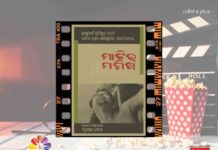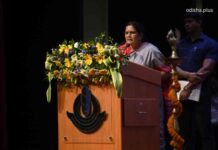Cinema can serve as the medium that can be a very impactful propagator and transmitter of a collective’s culture, value systems and lived realities
Isha Isita

The true inheritance of a collective in any walk of life is its ability to foster the cultural sense of beauty and harmony in its succeeding generations for it’s essential to the collective identity formation and sustenance of the community as a whole. A collective is managed by its laws but sustained by its culture as it’s the tangible and intangible manifestations of the collective culture which provides the ideological and internal cohesiveness of a community as beautifully elucidated in Benedict Anderson’s book ‘Imagined Communities’.
Cinema contains in its screens the blend of cultural manifestations of a collective ideology and value system, and also serves as a medium of negotiation with the same system to foster and nurture an ever progressing future. Thus it is a medium just like it’s sister literature within which the past strongholds of a culture can be celebrated and preserved while simultaneously systemic faults can be critiqued and important questions can be asked to build a more succinct and integrated future for the culture’s overall progress. But the most important contribution of cinema as a medium of dialogue perhaps lies in its ability to speak directly to its audience, thus making it an effective medium of both intra-culture and intercultural dialogue.
Cinema can serve as the medium that can be a very impactful propagator and transmitter of a collective’s culture, value systems and lived realities, thus forming the cultural and social identity of the collective especially in today’s cosmopolitan times of globalization and internet boom.
This multifarious role of films as a cultural dialogue and identity creating space was perhaps recognized by Odia intellectual and artistic community when in 1936 the Odia community saw the light of statehood and needed in the freshness of its independence from Bengali, British and Tamil influences to carve, nurture and reinforce its cultural identity through literature, arts and cinema as a result of which Odia film industry began its nascent beginning in a culturally nuanced Sita Bibah of Mohan Sunder Dev Goswami which sought to establish a new and differing Odia cultural identity by adapting India’s ancient mythological traditions to regional nuances and specificity. But unfortunately today the Odia film industry after equally glorious and struggling decades of effort to carve its own identities languishes in a harsh topography of low recognition, lack of funds and decreasing viewership slowly decimating in its importance as globalization brings to Odia homes and screens the more marketed works of the Hindi and international Film industries along with the lack of a strong academic, intellectual and research system backing the industry.
No state can flourish in its cultural landscape without aide of its literature and cinematic manifestations for it is writers, artists and filmmakers who establish for a state it’s cultural and social markers of identity and without which a modern state can very well lose its unique identity and break into a porous intagmelments of other dominant cultures and traditions as feared by New Marxist critic Stuart Hall.
In such a time of crisis in the industry the Bhubaneswar Film Circle has made a very laudable initiative in the worthy form of the Bhubaneswar Film Festival(BFF) to not only provide a platform to Odia film artists classical, parallel and contemporary to reach a wider audience and form an identity for themselves and the industry but also extends intellectual and critical support to the industry through its publications like the bilingual magazine Odia Cinema @90, Rhythms, Renditions and Reflections. The first edition of BFF held from June 7th, 2024 to June 9th, 2024, was inaugurated at Jayadev Bhawan, Bhubaneswar and sought to draw attention to classics of Odia film industry along with providing a platform for parallel cinema artists to showcase their works to a receiving audience.
Along with the screening of the films the Festival is laudable in its efforts to be a mediating space of dialogue on the industry between its practitioners and the general public ensuring Odia Cinema makes its presence heard just not in comfortable spaces of a few enthusiasts but to the wider world as such, an effort, an initiative and a platform that the industry was parched for a very long stretch of time.
The films screened at the festival ranged from classically revered films like Maya Mriga (1984) and Cha Mana Atha Guntha(1986 attempt of a book to screen translation of Fakir Mohan Senapati’s critically acclaimed Pre-independence novel) which transmitted the struggles of a nascent Odisha struggling with new forms of life ( Maya Mriga ) and brought the literature of Odisha with its succinct social commentary and regional critique of existing power systems to the fluid screen to contemporary parallel cinema like Shukha Asuchi (2014) and Jianata Bhoota (2008) which give voice to contemporary struggles of the Odia community and their dreams, desires and tears along with paying tributes to stalwarta of Odia cinema by not only screening documentaries like Remembering Pramod Patil but also by honouring contributing dignitaries like Namrata Das, Sachi Mohanty , Samresh Pal and Mohd. Musir, providing cultural acknowledgement of their underappreciated and underrepresented legacy in the industry.
The Film Festival true to its aim of providing space for dialogue between practitioners and enthusiasts held two masterclasses by eminent film personalities Mukesh Chabra and Amit Rai who briefed Odia film aspirants with the on-field realities and techniques of acting and screenwriting respectively to help them access wider opportunities. The film festivals most important contribution lies in its very laudable effort to launch the bilingual book ‘Odia Cinema @90, Rhythms, Renditions and Reflections’ which for the first time perhaps has given a platform for intellectual dialogue on Odia cinema paving the way for deeper and more rigorous research on Odia cinema in the near future.
In the dry landscape of the film industry of Odisha, Bhubaneswar Film Festival serves as a reinvigorating stream of freshness, providing a nuanced perspective to the industry and preparing a platform for the future of the industry from which it can dream of re-experiencing its lost glory and relevance. BFF understands the gravity and importance of its self taken responsibility and thus in 2025 it seeks to follow its past successful endeavor with another film festival from 6th to 9th June, 2025 which remains Odia in spirit but aims to be global in its form introducing Odia audiences to not just Odia classics but also invigorating works from other regional cinema making it a truly distinctive film festival.
(The author, a student of English Literature at Christ University, Bengaluru, is an intern with Bhubaneswar Film Circle. Views are personal)

























